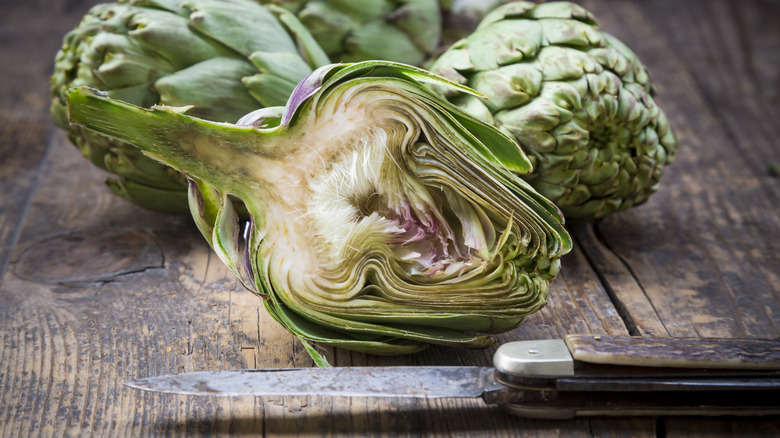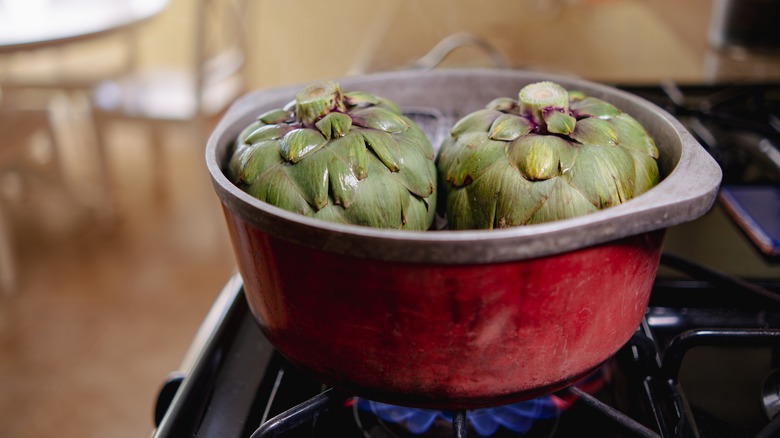The Absolute Best Way To Cook Artichokes
Artichokes are an inimitable vegetable teeming with fiber, antioxidants, and essential vitamins and minerals. Artichokes also have a complex and harmonious flavor profile marked by nutty accents, hints of sweetness, and herbal grassiness. Despite their depth of flavor, the taste of an artichoke is also delicate, which makes a proper cooking technique essential for preserving its subtleties.
There are various methods for cooking artichokes, such as grilling, roasting, and frying, and Daily Meal spoke with Chef Kieron Hales of Dexter, Michigan, event venue Zingerman's Cornman Farms to ascertain which is best. Of the many options, Hales states that steaming is the optimal technique for cooking artichokes. When they're not properly prepared, artichokes can be tough, sinewy, and hard to eat. Hales asserts that steaming "keeps the texture of the artichokes firm while ensuring a wonderfully tender finish."
Additionally, steaming is a relatively simple process. Once the food is in the steamer, you don't need to constantly monitor it — simply set a timer and let the steam do the work before cooling the artichokes at room temperature for 20 minutes, per Hales' advice. The chef notes that this makes clean-up easier, too, which is sure to be music to the ears of low-maintenance foodies.
Steaming artichokes has many benefits
Steaming artichokes doesn't just soften their texture and make for swift tidying. Hales tells us that it also helps preserve nutrients. Many of the super food–defining nutrients in artichokes are water-soluble, meaning that they dissolve easily in water. Therefore, minimizing their contact with liquid keeps them intact.
Although baking and grilling artichokes can help develop a golden-brown char, steaming them is the best way to safeguard their delicate, complex flavors. Steaming also plays a role in maintaining the artichokes' vibrant color, which can be diminished by other cooking methods. The bright green hue of steamed artichokes is not only visually appealing but is also indicative of the preserved chlorophyll, an important antioxidant.
For climate-conscious eaters, steaming artichokes is an environmentally friendly choice as it requires less of your stove's power and time than roasting or frying. By choosing steaming over other methods, you contribute to more sustainable cooking practices while still achieving a delicious and nutritious result — what's not to love?
Uses for steamed artichokes
To prepare an artichoke for steaming, trim the stem to about an inch from the base. Remove the tough outer leaves near the base and cut off about an inch from the top of the artichoke to remove the prickly tips. Once they're steamed, it's time to turn those tender buds into full-fledged meals for personal enjoyment or family-style sharing.
No recipe captures the essence of an artichoke quite like spinach and artichoke dip. Timeless, creamy, and perfect for dipping, scooping, and smothering, this rich-tasting provision works well alongside warm pita bread, garden-fresh vegetables, salted tortilla chips, or roasted meats. For a pro-tip, Hales encourages foodies to "finely dice the artichokes to break down any of the fibers and make the dip as smooth as possible." For an alternative dip, Hales suggest "a fresh homemade yogurt with the wonderful flavors of mint [and] cucumber and the addition of artichokes."
Artichokes are a secret weapon in many Italian recipes. Adding steamed artichokes to a summer vegetable pizza brings extra dimension to the rich, cheesy flavors and a tenderized, textural contrast to the crispy crust. Combine steamed artichokes with olives, sun-dried tomatoes, capers, fusilli noodles, and pesto for a Mediterranean-inspired pasta salad teeming with satiating, flavorful nutrients. Steamed artichokes also work well as unique burger and sandwich toppers or frittata fillers. For a simple option, smother them in melty herbed butter and pluck them from the head, dip them in marinara, and enjoy this as a pre-dinner appetizer.


